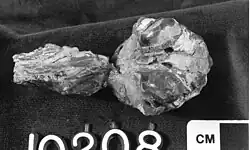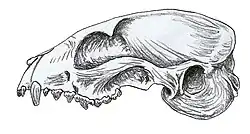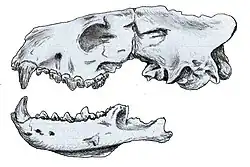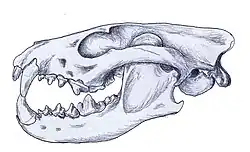The Sharps Formation is a geologic formation in South Dakota . It preserves fossils dating back to the Paleogene .[ 1]
The Sharps Formation is the namesake of the community of Sharps Corner, South Dakota .[ 2]
Fossil content Color key Notes small text ; crossed out taxa are discredited.
Mammals
Carnivorans Carnivorans reported from the Sharps Formation Genus Species Location Stratigraphic position Material Notes Images Archaeocyon A. leptodus Shannon & Jackson counties, South Dakota.[ 3] Middle & upper part of the formation.[ 3] Skull elements.[ 3] A borophagine dog. A. pavidus Southeast corner of Sheep Mountain, Shannon County, South Dakota .[ 3] Lower part of the formation.[ 3] 2 partial skeletons.[ 3] A borophagine dog. Cormocyon C. haydeni Wounded Knee area, Shannon County, South Dakota .[ 3] Upper part of the formation.[ 3] Left maxillary (F:AM 49436).[ 3] A borophagine dog. Cynarctoides C. lemur Shannon County, South Dakota .[ 3] Lower & upper parts of the formation.[ 3] Jaw elements.[ 3] A borophagine dog also known from the John Day , Brule & Browns Park formations. C. roii Wounded Knee Area, Shannon County, South Dakota .[ 1] [ 3] Upper part of the formation.[ 3] Skull elements.[ 1] [ 3] A borophagine dog also known from the lower Arikaree Group Cynodesmus C. cooki Wounded Knee Area.[ 1] Mandibles.[ 1] Reassigned to the genus Otarocyon [ 3] Ekgmoiteptecela E. olsontau Wounded Knee Area.[ 1] Rockyford Member.[ 1] Right ramus (SDSM 54247).[ 1] Junior synonym of Hoplophoneus cerebralis[ 4] Enhydrocyon E. crassidens Wounded Knee Area.[ 1] Crania .[ 1] A hesperocyonine dog also known from the Harrison Formation . E. pahinsintewakpa Wounded Knee Area.[ 1] [ 5] Near the top of the formation.[ 5] Right mandible.[ 1] [ 5] A hesperocyonine dog. Hesperocyon H. leptodus Wounded Knee Area.[ 1] Skull elements.[ 1] Reassigned to the genus Archaeocyon [ 3] Hoplophoneus H. cerebralis Wounded Knee Area, South Dakota.[ 1] [ 4] Rockyford Member.[ 1] Right ramus (SDSM 54247).[ 1] A nimravid . Leptocyon L. douglassi Wounded Knee Area.[ 6] Maxillary fragments.[ 6] A canine dog also known from the Toston & John Day formations. Mesocyon M. robustus Wounded Knee Area.[ 1] Mandibles.[ 1] A hesperocyonine dog. "M." temnodon Shannon County, South Dakota .[ 5] Basal part and near the top of the formation.[ 5] Rami .[ 5] A hesperocyonine dog. Nothocyon N. geismarianus Wounded Knee Area.[ 1] Jaw elements.[ 1] An arctoid formerly thought to be a canid , also known from the Monroe Creek Formation . N. lemur Wounded Knee Area.[ 1] [ 3] Jaw elements.[ 1] [ 3] Reassigned to Cynarctoides N. roii Wounded Knee Area.[ 1] [ 3] Skull elements.[ 1] [ 3] Reassigned to Cynarctoides Otarocyon O. cooki Wounded Knee Area, Shannon County, South Dakota .[ 3] Upper part of the formation.[ 3] Partial rami .[ 3] A small borophagine dog also known from the lower Arikaree Group . Palaeogale P. dorothiae Wounded Knee Area.[ 1] Fragment of right mandible (SDSM 53326).[ 1] A palaeogalid . Paradaphoenus P. tooheyi South Dakota.[ 7] Maxilla (LACM 21649).[ 7] A bear-dog . Philotrox P. condoni Wounded Knee area, Shannon County & Quiver Hill localities, Washabaugh County .[ 5] Middle member.[ 5] Skull and jaw remains.[ 5] A hesperocyonine dog also found in the John Day Formation . Sunkahetanka S. geringensis Wounded Knee Area, Shannon & Jackson counties.[ 1] [ 5] Middle member.[ 5] Jaw elements.[ 1] [ 5] A hesperocyonine dog also known from the topmost part of the Brule Formation . S. pahinsintewakpa Wounded Knee Area.[ 1] Right mandible.[ 1] Reassigned to Enhydrocyon
Eulipotyphlans
Lagomorphs
Primates Primates reported from the Sharps Formation Genus Species Location Stratigraphic position Material Notes Images Ekgmowechashala E. philotau Wounded Knee Area.[ 1] Jaw elements.[ 1] An adapiform .
Rodents
Ungulates
Reptiles
Squamates
See also
References ^ a b c d e f g h i j k l m n o p q r s t u v w x y z aa ab ac ad ae af ag ah ai aj ak al am an ao ap aq ar as at au av aw ax ay az ba bb bc bd be bf bg bh bi bj bk bl bm bn bo bp bq br bs bt bu bv bw bx by bz ca cb cc cd ce cf cg ch ci cj ck cl cm cn co cp cq cr cs ct cu cv cw cx cy cz da db dc dd de df dg dh di dj dk dl dm dn do dp dq dr ds dt du dv dw dx dy dz ea eb ec ed ee ef eg eh ei ej ek el em en eo ep eq er Macdonald, J. R. (James Reid); Thomson, Albert Report of the expedition of 1906 to the Miocene on Pine Ridge Indian Reservation (1963). "The Miocene faunas from the Wounded Knee area of western South Dakota. article 3" . Bulletin of the AMNH . 125 . hdl :2246/1259 . {{cite journal}}: CS1 maint: numeric names: authors list (link)^ Harksen, J. C.; Macdonald, J. R.; Sevon, W. D. (1961). "New Miocene Formation in South Dakota" (PDF) . p. 2. Retrieved 2022-10-05 – via South Dakota Geological Survey. ^ a b c d e f g h i j k l m n o p q r s t u v w x Wang, Xiaoming; Tedford, Richard H.; Taylor, Beryl E. (1999). "Phylogenetic systematics of the Borophaginae (Carnivora, Canidae)" . Bulletin of the AMNH (243): 9– 391. hdl :2246/1588 . ^ a b Barrett, Paul Z. (2016-02-09). "Taxonomic and systematic revisions to the North American Nimravidae (Mammalia, Carnivora)" . PeerJ . 4 : e1658. doi :10.7717/peerj.1658 ISSN 2167-8359 . PMC 4756750 PMID 26893959 . ^ a b c d e f g h i j k l Wang, Xiaoming (1994). "Phylogenetic systematics of the Hesperocyoninae (Carnivora, Canidae)" . Bulletin of the AMNH (221). hdl :2246/829 . ^ a b Tedford, Richard H.; Wang, Xiaoming; Taylor, Beryl E. (2009). Phylogenetic systematics of the North American fossil Caninae (Carnivora, Canidae). (Bulletin of the American Museum of Natural History, no. 325) hdl :2246/5999 . ^ a b Hunt, Robert M. (2001). "Small Oligocene amphicyonids from North America (Paradaphoenus, Mammalia, Carnivora)" . American Museum Novitates (3331): 1– 20. doi :10.1206/0003-0082(2001)330<0001:BAOTLL>2.0.CO;2 . hdl :2246/2884 . S2CID 83979855 . ^ a b c d e f g h i j k l m Hutchison, J. Howard (1972-12-29). "Review of the Insectivora from early Miocene Sharps formation of South Dakota" . Contributions in Science . 235 : 1––16. doi :10.5962/p.241219 ISSN 0459-8113 . S2CID 134450974 . ^ a b Korth, William W. (1994). "Middle Tertiary Marsupials (Mammalia) from North America" Journal of Paleontology . 68 (2): 376– 397. Bibcode :1994JPal...68..376K . doi :10.1017/S0022336000022952 . ISSN 0022-3360 . JSTOR 1306077 . S2CID 130386546 . ^ a b c d Parris, David C.; Green, Morton (1969). "Dinohyus (Mammalia: Entelodontidae) in the Sharps Formation, South Dakota" . Journal of Paleontology . 43 (5): 1277– 1279. ISSN 0022-3360 . JSTOR 1302440 . ^ a b Hembree, Daniel I. (April 30, 2007). "Phylogenetic revision of Rhineuridae (Reptilia: Squamata: Amphisbaenia) from the Eocene to Miocene of North America" . The University of Kansas Paleontological Contributions (15): 1– 20. doi :10.17161/PCNS.1808.3763 hdl :1808/3763 S2CID 59354440 . ^ a b c Scarpetta, Simon G. (October 2019). "Peltosaurus granulosus (Squamata, Anguidae) from the Middle Oligocene of Sharps Corner, South Dakota, and the Youngest Known Chronostratigraphic Occurrence of Glyptosaurinae" Journal of Vertebrate Paleontology . 39 (3): e1622129. Bibcode :2019JVPal..39E2129S . doi :10.1080/02724634.2019.1622129 . ISSN 0272-4634 . S2CID 196690362 .

_fig._6.png)









Lower_Miocene_of_Nebraska.jpg)


_1_(32312306045).jpg)

